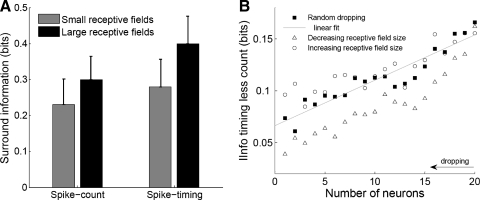FIG. 3.
Surround spike-timing code A: large vs. small receptive fields. Surround responses conveyed more information about stimulus location and the additional information conveyed by spike timing over spike count was greater in subpopulations of neurons with large receptive fields compared with subpopulations of neurons with small receptive fields. Whiskers represent 95% confidence intervals. B: population coding. The additional information provided by spike timing over spike count, i.e., the information extracted with spike timing less the information extracted with spike count (y axis), linearly increased as the number of neurons increased (x axis). Random neuron dropping (▪) was compared with neuron dropping by increasing receptive field size (○) and by decreasing receptive field size (▵). The additional information extracted using spike timing over spike count significantly decreased when dropping neurons with the largest receptive field size compared with random neuron dropping.

